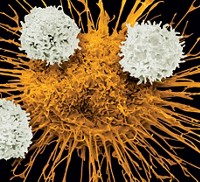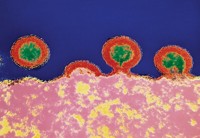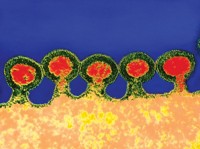Advertisement
Grab your lab coat. Let's get started
Welcome!
Welcome!
Create an account below to get 6 C&EN articles per month, receive newsletters and more - all free.
It seems this is your first time logging in online. Please enter the following information to continue.
As an ACS member you automatically get access to this site. All we need is few more details to create your reading experience.
Not you? Sign in with a different account.
Not you? Sign in with a different account.
ERROR 1
ERROR 1
ERROR 2
ERROR 2
ERROR 2
ERROR 2
ERROR 2
Password and Confirm password must match.
If you have an ACS member number, please enter it here so we can link this account to your membership. (optional)
ERROR 2
ACS values your privacy. By submitting your information, you are gaining access to C&EN and subscribing to our weekly newsletter. We use the information you provide to make your reading experience better, and we will never sell your data to third party members.
Pharmaceuticals
Healing Viruses
Researchers take cancer-fighting viruses from bench to bedside
by Aaron A. Rowe
September 5, 2011
| A version of this story appeared in
Volume 89, Issue 36

More than 100 years ago, doctors noticed that some viruses have a remarkable ability to kill cancer cells while leaving healthy tissue almost unharmed. Since then, researchers have been trying to develop such viruses as treatments for cancer, but it’s only in recent years that their century of effort has begun to bear fruit. Now, a dozen oncolytic viruses are being tested in the clinic, with a couple poised to gain Food & Drug Administration approval in the next two years.
That brimming pipeline has many scientists in the field feeling confident. Most viral cancer agents in development have been shown to be safe and fairly effective, says Matt Coffey, cofounder of Oncolytics Biotech, one of three companies with cancer-killing viruses in Phase III human trials.
Until recently, it was widely believed that oncolytic viruses exerted their anticancer effects solely by replicating within malignant cells and then destroying them. But several studies have called that viewpoint into question, and at least one additional factor now seems to be at play, explains Richard G. Vile, an immunologist at the Mayo Clinic. In addition to killing cancer cells by replicating within them, the viruses provoke the immune system to more aggressively recognize and fight cancer. In other words, the oncolytic virus also works like a cancer vaccine, Vile explains.
“I think ultimately the strategy is going to be to use the virus infection to reduce the tumor burden—sort of a biologic surgery, initially,” says Timothy Cripe, an oncologist at Cincinnati Children’s Hospital Medical Center, where four oncolytic virus trials are taking place. Later in a course of treatment, he says, doctors may also use the viruses “to sensitize the immune response to keep the tumors from growing back.”
In recent studies, oncolytic viruses have shown substantial signs of efficacy. The results are good enough that Amgen recently acquired BioVex and its Phase III oncolytic virus candidate (C&EN, Jan. 31, page 8). “If we do achieve the kind of clinical results that we are hoping for, it really will have a major effect on the field of oncology,” says Joe Miletich, Amgen’s senior vice president of R&D.
Many early victories in the field of oncolytic viruses were brought about by localized injections directly into tumors. Those localized doses are quite small compared with the systemic treatments that are being tested today. Only recently has it become viable to administer long courses and long doses of viruses systemically. That’s because producing enough of the viruses to conduct large, systemic trials is challenging.
Coffey notes that Oncolytics Biotech turned to Sigma-Aldrich for help in preparing enormous quantities of virus that can be given alongside traditional chemotherapy. He says Sigma-Aldrich took a huge risk when it got into the virus production game but that the gamble has paid off for the company. The chemical firm acquired a massive production facility that has made his company’s large clinical trials of oncolytic virus agents possible.
“With improved production techniques, we’re seeing the field grow much more rapidly just because you can suddenly entertain larger studies,” Coffey says. “You can mass-produce these now, which had been a challenge for some of these modified vectors before.”
However, several problems continue to limit the effectiveness of oncolytic viruses. For one, diagnostics that could be used to select the right virus for a patient are still at a very early academic stage, so doctors currently have no way to predict whether particular viruses will be effective for their patients. For example, JX-594, a modified vaccinia virus developed by Jennerex Biotherapeutics recently showed impressive efficacy in some cancer patients, but those results were not consistent, explains Evanthia Galanis, an oncologist at the Mayo Clinic (Nature, DOI: 10.1038/nature10358).
Molecular tests that check for cancer cell types could help. For instance, Reolysin, a particularly innocuous virus developed by Oncolytics Biotech, prefers to replicate in cancer cells with an active Ras signaling pathway. Cells that have active Ras don’t produce a defensive protein called PKR, and that leaves them vulnerable to viral attack.
Empirical tests for viral replication within a patient’s cancer cells might also help. Several teams have explored adding markers to viruses and then administering the combination simultaneously at a low dose. A virus that enters cancer cells could then be identified by its marker.
Scientists are also trying to optimize cell delivery of viruses. Some have modified viruses with peptides that help them invade tumor cells. Others have found that the precise timing of a virus injection matters—that there is a window after standard chemotherapy drugs have been administered when virus will have stronger ef fects.
Researchers are also looking into using stem cells as viral delivery vehicles. In theory, this could allow constant, long-term delivery of viral particles. The first human trial of a treatment that uses stem cells as virus carriers could begin within a year, according to Galanis.
In addition, researchers will need to develop new ways to make sure viruses destroy metastases, which ultimately are what usually kill patients, Cripe says.
A key problem in administering oncolytic viruses is that they have a hard time getting through the thick layers of extracellular matrix that often surround tumors. Some researchers have tried to modify viruses to increase their chances of surmounting this barrier. One strategy is to add proteases to the surface of each virus, Coffey says.
And although oncolytic viruses can be highly selective for cancer cells, some tend to accumulate in the liver when they are administered systemically. To reduce the risk of liver damage from the expression of viral genes in noncancerous liver cells, several teams have started inserting gene-silencing microRNA sequences into the viruses (Nat. Biotechnol., DOI: 10.1038/nbt1208-1346). This is like creating a “tear here” perforation in the virus: If it enters a liver cell, it’s toast.
If oncolytic viruses make it to cancer patients’ bedsides, it’s likely the viruses will do it in combination with traditional cancer drugs. There seems to be a great deal of synergy between the two, Coffey says. Drugs such as carboplatin and paclitaxel stabilize sites where viruses bind to host proteins, allowing the viruses to replicate more easily.
To further enhance the synergy of drug-virus combinations, many groups have begun adding drug- or radiation-sensitizing genes to oncolytic viruses. Adding genes that give viruses greater cell-penetrating ability could also be helpful, Coffey says. “There has been a lot of academic work in viruses to sort of mix and match and get the benefits of everything that you possibly can in one vector,” he says.






Join the conversation
Contact the reporter
Submit a Letter to the Editor for publication
Engage with us on Twitter